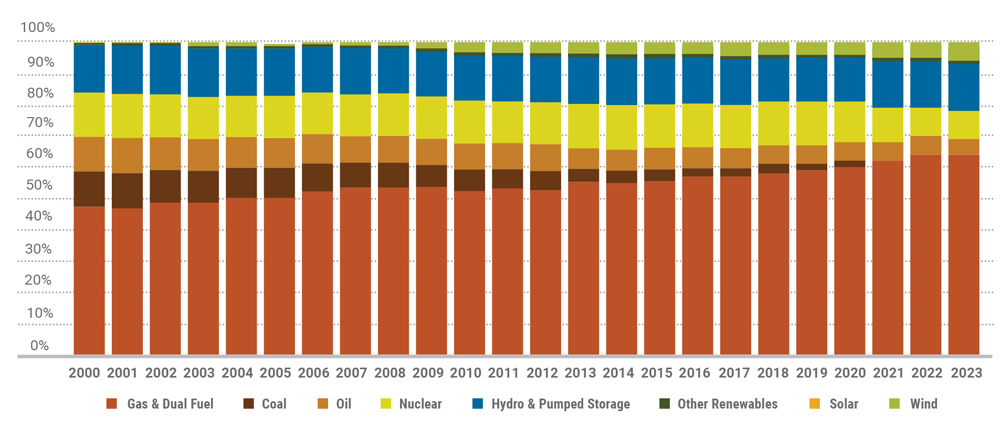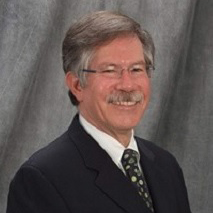PROVIDENCE, R.I. — As a haze of smoke and particulate matter from several massive Canadian wildfires engulfed the Northeast last week, energy industry leaders met in the 17th floor ballroom of the Graduate Providence hotel to discuss some of the challenges and opportunities of decarbonization.
Much of the discussion, hosted by the Northeast Energy and Commerce Association at the 29th annual New England Energy Conference and Exposition, centered around how the region can improve the financing of large clean energy projects, including potential market mechanisms to supplant the current reliance on power purchase agreements.
Over the past several years, New England states and stakeholders have discussed the potential for regionwide clean energy market mechanisms, such as a carbon price or a forward clean energy market (FCEM), but have struggled to come to a consensus on any such program. (See NECA Panel Ponders Forward Clean Energy Market.)
Joanna Troy, director of energy policy and planning at the Massachusetts Department of Energy Resources (DOER), said creating a market framework to incentivize large clean energy projects could help ratepayers across New England save money. She referenced the 2022 “pathways analysis,” commissioned by ISO-NE, that found the status quo of state-led PPAs to be more expensive than alternatives like a forward clean energy market, a carbon price or a hybrid.
The DOER under the administration of former Gov. Charlie Baker released a proposal for a regional FCEM in January; it outlined the creation of an independent nonprofit to oversee the market, with representatives from each New England state. Stakeholders including utilities, state agencies, municipalities and companies would voluntarily purchase different types of clean energy certificates, which would help provide financing for renewable resources.
In May, the Massachusetts Executive Office of Energy and Environmental Affairs, in consultation with the DOER and Department of Public Utilities, released a report on clean energy markets, concluding that the “use of a regional or multistate, market‐based approach to facilitate the development of clean energy generation resources — and, more broadly, to achieve and maintain a clean, reliable and affordable energy resource mix — could result in lower costs to consumers and would be beneficial for the commonwealth.”
However, the state said additional collaboration with other New England states would be necessary to develop and implement this approach and cautioned that implementing an FCEM would take years.
Thus, “Massachusetts must collaborate with its regional partners and explore more expedient market‐based approaches to support the development of clean energy, the achievement of state decarbonization requirements and reduced consumer costs,” the state concluded.

“All options are on the table for how we get to a world in 2050 where we have this innovative clean energy market,” Troy said.
Susannah Hatch, director of clean energy policy at the Environmental League of Massachusetts, said studies show it will be extremely difficult to reach net-zero emissions without placing a meaningful carbon price, which should not be limited to the electricity sector.
“Having an economywide carbon price will be really important to make sure that we’re not disincentivizing electrification in other sectors,” Hatch said.
Aleks Mitreski, senior director of regulatory affairs at Brookfield Renewable Energy, said issues related to cost allocation and “finance-ability” for developers of clean energy projects have come up while trying to design a carbon pricing scheme, but he called carbon pricing “probably the easiest and best thing to do from an economic standpoint, if we can get that done.”
Hatch said an FCEM could be a useful tool but expressed concerns that a cost-based mechanism could overlook other important factors.
“While markets are really amazing at getting the lowest-cost projects and driving down costs for consumers, which is really important, they do not do quite as good a job of valuing some of the things we care about, such as environmental protection; diversity, equity and inclusion; labor standards; environmental justice; etc.,” Hatch said.
Panelists also stressed that market mechanisms must account for the variable reliability attributes of different clean energy resources, over both short- and long-term horizons.
“If we define the services that we need, then that provides the revenue opportunities for the markets to procure those services, so that we get the sort of resource mixes that will ultimately provide the region with the reliability we need as we move towards a lot more non-carbon-emitting resources,” said Chris Geissler, manager of economic analysis at ISO-NE.
Geissler highlighted the RTO’s work on the Day-Ahead Ancillary Services Initiative, which would provide new incentives for short-term reliability resources within the day-ahead market. (See ISO-NE Plans 2025 Launch for Day-Ahead Ancillary Services Initiative.)
Verifying Clean Hydrogen
As federal investment spurs interest in hydrogen development, Bob Grace, president of consultancy Sustainable Energy Advantage, made the case for a comprehensive hydrogen tracking system to verify the emissions intensity of hydrogen, tracking it from production to end use.
“At present, there is no established system for green hydrogen to be tracked and attributed between source and use,” Grace said. “A clean or green hydrogen tracking system is needed — and it’s needed soon — to enable a credible landscape for hydrogen.”
The federal tax credits created in the Inflation Reduction Act are based on a tiered system of carbon intensity: the lower the lifetime carbon intensity of the hydrogen, the greater the tax credit received.
Grace said a centralized tracking system that is not limited by geography will be essential to ensuring that hydrogen is as clean as it claims to be and that parties investing in hydrogen can rely on a framework to support due diligence and contracting. He added that the system will need to be able to track hydrogen as it is transported, stored and blended with nonrenewable fuels, while accounting for losses along the way.
“Going forward, we’re looking to pull together interested stakeholders, create a stakeholder process and find the funding to take this to the next step,” Grace said.
Cyrus Tingley of Plug Power said that while the hydrogen market has not yet been overly concerned about verification, “for it to be sustainable and bankable long term, we need it. … There’s a big volume of projects and effort out there that will ultimately depend really strongly on this.”
Tingley agreed that a multistakeholder process will be needed to create a workable verification system, overseen by a trusted and independent organization.

